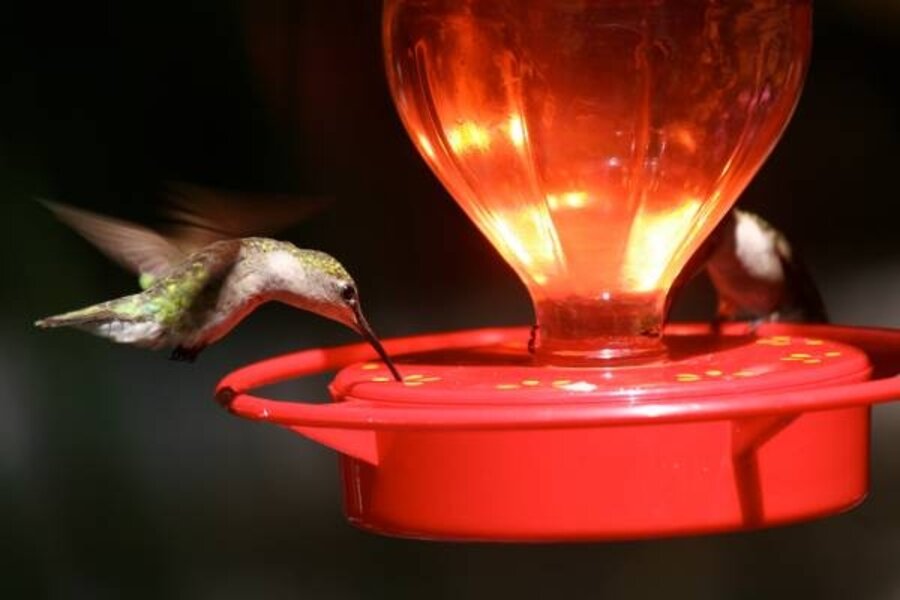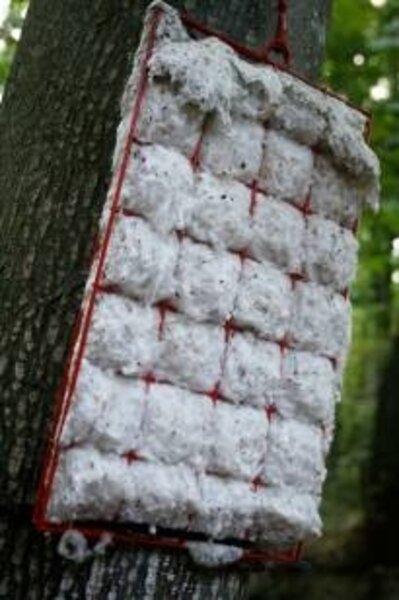How to attract birds to your garden
Loading...
Backyard bird watching is a fairly simple exercise. Provide enough food, water, and cover, and birds will come flocking. Playing favorites, though, calls for using the right kinds of incentives.
Hummingbirds, for example, will linger longer if you offer nesting material to help cushion their pea-size eggs. "Goldfinches and titmice go for it, too. Lots of birds," says Mel Toellner, whose company, Songbird Essentials in Mexico, Mo., makes a fluff-stuffed enclosure called the "Hummer Helper." Instead of hunting for filler – primarily spider webs or moss – hummingbirds can pick up what they need from this fiber-filled device.
"It's the nesting equivalent of stopping at a McDonalds," Mr. Toellner says. "Hummingbirds will return to the same place year after year when they find a situation they like. These units help build high-density populations."
Hummingbirds fledge as many as three broods per season, so Toellner suggests placing nest-building kits near feeders. The containers are priced at around $12; refills of the natural, oil-rich cotton cost about $6.
Another way to attract hummingbirds is to signal that food is available.
"Hummingbirds react favorably to the color red, so wrap some bright red ribbons around trees or poles where scouts can see them" during the spring migration, Toellner says. "The birds will come down to investigate."
Hummingbirds survive chiefly on a liquid diet, preferably high-energy syrup from flowers or feeders. Nectars can be color free, but the foraging is made easier if feeders are red.
Mourning doves, cardinals, blue jays, towhees, and juncos are among the many bird species that prefer feeding from the ground or from platform feeders.
"Spread a little cracked corn or millet on the ground," says Elaine Cole, president of Cole's Wild Bird Products Co. in Kennesaw, Ga. "I emphasize just a little, however, because it could get wet and become a source of mold or contamination. Platform feeders with screens on them are a better alternative than simply throwing feed on the ground. It often spoils before the birds can eat it."
Some other wild bird magnets:
– Moving water. This can range from the sound of a small waterfall, refreshing spray from a mister or the sight of ripples across a pond. Electric- or solar-powered pumps can also keep water fixtures free of scum and mosquitos. The water should be changed regularly or at least every other day during hot weather. Immersion heaters keep birdbaths clear of ice in winter.
– Fruit, jams, and jellies. "My No. 1-selling feeder is a jelly feeder," Toellner said. "Jelly will bring up orioles, mockingbirds, and catbirds to feed." The plastic apparatus fits on top of 10- or 12-ounce jelly jars and provides a place to perch.
– Protein-rich worms. Look to bait shops for a steady supply of live meal worms or wax worms.
– A few fruit-filled pie pans tossed onto the ground will collect insects. "Use fleshy fruits like peaches, guavas and bananas for this," Toellner said. "The fruit flies will come for the fruit and the birds will come for the small insects."
– Super-size it. Elongated suet feeders provide support for woodpeckers, which tend to use their strong tails for balance as they eat. These feeders generally hold two suet cakes, one basket on each side of a board.
Where and how you feed wild birds can be just as important as what you feed them, especially if you're trying to attract just a few favored species.
Encourage small birds, for instance, by putting up specialty feeders that restrict access.
"Wood feeders with vertical bars and feeders covered with wire mesh frustrate the larger birds," says a US. Fish and Wildlife Service fact shees. "Tube feeders without trays also restrict access to small birds. Remove the perches and you've further selected only those birds capable of clinging – finches, chickadees, titmice and woodpeckers. Add vertical perches to tube thistle (nyjer) feeders and you'll limit accessibility primarily to the goldfinches."
Tips on choosing seed
Birds can be as finicky as people about what they eat. So the varieties of birds you attract to your yard will be determined primarily by the kind of seed you offer.
"Watch a feeder filled with a seed mix and you'll see the birds methodically drop or kick out most of the seeds to get to their favorite – sunflower," the US. Fish and Wildlife Service says in a bird feeding fact sheet. "Birds will also kick out artificial 'berry' pellets, processed seed flavored and colored to look like 'real' fruit."
The most effective way to attract a large variety of birds is to put out separate feeders for each food, the agency says. Here is a Fish and Wildlife Service guide matching birds with their favorite foods:
Cracked corn: ducks, geese, quail, mourning doves.
Nyjer: finches, pine siskins, chickadees, dark-eyed juncos, redpolls, doves, and sparrows.
Nectar: hummingbirds, cardinals, thrushes, orioles, tanagers, finches.
Fruit: orioles, mockingbirds, cedar waxwings, tanagers, bluebirds, jays, cardinals, thrushes.
Peanuts: woodpeckers, chickadees, and titmice.
Millet: doves, blackbirds, sparrows, juncos, towhees.
If you want to feed only doves, cardinals, and white-throated sparrows, then switch from black oil sunflower to safflower seed, the agency says.
When is the best time to feed? Many people say all year if you enjoy the sights and sounds of birds.
"Birds can benefit from an additional food source in winter, but the really good time to feed is spring going into summer," says Ms. Cole. "They've got a lot of chicks just coming out (of the nest) and the adults will bring them to the feeders. There's still a lot of migration going on, too.
"Many natural foods haven't matured yet and a lot of insects aren't out in force," Cole says. "So feeding birds at that time works well for them."
Editor's note: For more garden articles – at least one new one each weekday – click here. And don't forget to bookmark and drop by our lively garden blogs. Click here for the RSS feed of all our gardening content. You can also follow us on Twitter.






